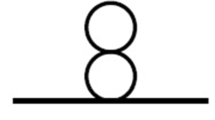Abstract
Ultraviolet renormalization of position space massless Feynman amplitudes has been shown to yield associate homogeneous distributions. Their degree is determined by the degree of divergence while their order—the highest power of logarithm in the dilation anomaly—is given by the number of (sub)divergences. In the present paper we review these results and observe that (convergent) integration over internal vertices does not alter the total degree of (superficial) ultraviolet divergence. For a conformally invariant theory internal integration is also proven to preserve the order of associate homogeneity. The renormalized 4-point amplitudes in the φ4 theory (in four space-time dimensions) are written as (non-analytic) translation invariant functions of four complex variables with calculable conformal anomaly.
Our conclusion concerning the (off-shell) infrared finiteness of the ultraviolet renormalized massless φ4 theory agrees with the old result of Lowenstein and Zimmermann [23].
Similar content being viewed by others
References
S. Bloch, “Applications of the dilogarithm functions in algebraic K-theory and algebraic geometry”, in Proceedings of the International Symposium on Algebraic Geometry (Kinokuniya, Tokyo, 1978).
S. Bloch, H. Esnault, and D. Kreimer, “On motives and graph polynomials”, Commun. Math. Phys. 267, 181–225 (2006), arXiv:math/0510011.
S. Bloch and D. Kreimer, “Mixed Hodge structures and renormalization in physics”, Commun. Number Theory Phys. 2, 637–718 (2008); arXiv:0804.4399[hepth]. “Feynman amplitudes and Landau singularities for 1-loop graphs”, arXiv:1007.0338[hep-th].
N. N. Bogoliubov and D. V. Shirkov, Introduction to the Theory of Quantized Fields, 3d Ed. (Wiley, 1980) (Russian edition, 1957).
D. J. Broadhurst, “Summation of an infinite series of ladder diagrams”, Phys. Lett. B 307, 132–139 (1993).
D. J. Broadhurst, “Multiple Deligne values: A data mine with empirically tamed denominators”, arXiv:1409.7204[hep-th]. ?4
D. J. Broadhurst and D. Kreimer, “Knots and numbers in to 7 loops and beyond”, Int. J. Mod. Phys. 6C, 519–524 (1995). “Association of multiple zeta values with positive knots via Feynman diagrams up to 9 loops”, Phys. Lett. B 393, 403–412 (1997), arXiv:hep-th/9609128.
D. Broadhurst and O. Schnetz, “Algebraic geometry informs perturbative quantum field theory”, Proc. Sci. 211, 078 (2014), arXiv:1409.5570.
F. Brown, “Single valued multiple polylogarithms in one variable”, C. R. Acad. Sci. Paris Ser. I 338, 522–532 (2004).
F. Brown, “Single-valued periods and multiple zeta values”, arXiv:1309.5309[math.NT].
F. Brown and D. Kreimer, “Angles, scales and parametric renormalization”, arXiv:1112.1180[hep-th].
F. Brown and O. Schnetz, “Proof of the Zig-zag conjecture”, arXiv:1208.1890v2[math.NT].
K. G. Chetyrkin, A. I. Kataev, and F. V. Tkachov, “New approach to evaluation of multiloop Feynman integrals: The Gegenbauer polynomial x-space technique”, Nucl. Phys. B 174, 345–377 (1980).
C. Duhr, “Hopf algebras, coproducts and symbols: Application to Higgs boson amplitudes”, arXiv:1203.0454[hep-ph].
F. J. Dyson, “Missed opportunities”, Bull. Am. Math. Soc. 78 (5), 635–652 (1972).
H. Epstein and V. Glaser, “The role of locality in perturbation theory”, Ann. Inst. H. Poincaré A 19 (3), 211–295 (1973).
K. Frednhagen and K. Rejzner, “QFT on curved spacetimes: Axiomatic framework and examples”, J. Math. Phys., 57 (2016) 031101, arXiv:1412.5125v2[math-ph]; “Perturbative construction of models of algebraic Quantum Field Theory”, arXiv:1503.07814[math-ph].
J. M. Gracia-Bondia, “Systematic renormalization at all orders in the DiffRen and improved Epstein-Glaser schemes”, in Proceedings of the Conference “Quantum Mathematical Physics” (Regensburg, 2014), arXiv:1507.06493[hep-th].
J. M. Gracia-Bondia, H. Gutierrez-Garro, and J. C. Varilly, “Imroved Epstein-Glaser renormalization in x-space, III Versus differential renormalization”, Nucl. Phys. B 886, 824–869 (2014), arXiv:1403.1785v3.
S. Hollands and R. M. Wald, “Axiomatic quantum field theory on curved spacetime”, Commun. Math. Phys. 293, 85–125 (2010); arXiv:0803.2003[gr-qc]; “Quantum field theory on curved spacetime, operator product expansion, and Dark energy”, Gen. Rel. Grav. 40, 2051–2059 (2008), arXiv:0805.3419[gr-qc].
L. Hörmander, The Analysis of Linear Partial Differential Operators, I: Distribution Theory and Fourier Analysis, 2d Ed. (Springer, 1990).
M. Kontsevich and D. Zagier, “Periods”, in Mathematics- 20101 and Beyond, Ed. by B. Engquist and W. Schmid (Springer, Berlin, 2001), pp. 771–808.
J. H. Lowenstein and W. Zimmermann, “On the formulation of theories with zero-mass propagators”, Nucl. Phys. B 86, 77–103 (1975).
J. W. Milnor, “Hyperbolic geometry: The first 150 years”, Bull. Am. Math. Soc. 6 (1), 9–24 (1982).
S. Müller-Stach, “What is a period?”, Notices AMS (2014), arXiv:1407.2388[math.NT].
N. M. Nikolov, R. Stora, and I. Todorov, Euclidean Configuration Space Renormalization, Residues and Dilation Anomaly, Geneva/Annecy Preprint CERN-THPH/ 2012-076, LAPTH-Conf-016/12; in Proceedings of the Varna Workshop “Lie Theory and Its Applications in Physics” (LT9), Ed. by V. K. Dobrev (Springer, Japan, Tokyo, 2013), pp. 127–147.
N. M. Nikolov, R. Stora, and I. Todorov, “Renormalization of massless Feynman amplitudes as an extension problem for associate homogeneous distributions”, Rev. Math. Phys. 26 (4), 1430002 (2014); CERN-TH-PH/2013-107, arXiv:1307.6854[hep-th].
E. Panzer, “Feynman integrals via hyperlogarithms”, Proc. Sci. 211, 049 (2014), arXiv:1407.0074[hep-ph].
O. Schnetz, “Quantum periods: A census of transcendentals”, Commun. Number Theory Phys. 4 (1), 1–48, arXiv:0801.2856v2.
O. Schnetz, “Graphical functions and single-valued multiple polylogarithms”, Commun. Number Theory Phys. 8 (4), 589–685 (2014), arXiv:1302.6445[math.NT].
I. Todorov, “Polylogarithms and multizeta values in massless Feynman amplitudes”, in Lie Theory and Its Applications in Physics (LT10), Ed. by V. Dobrev; Springer Proceedings in Mathematics and Statistics, Vol. 111 (Springer, Tokyo, 2014), pp. 155–176; Buressur-Yvette Preprint IHES/P/14/10.
F. Wilczek, “Origins of mass”, arXiv:1206.7114v2[hep-ph].
D. Zagier, “The dilogarithm function”, in Frontiers in Number Theory, Physics and Geometry II, Ed. by P. Cartier (Springer, Berlin, 2006), pp. 3–65.
Author information
Authors and Affiliations
Corresponding author
Additional information
The article is published in the original.
Rights and permissions
About this article
Cite this article
Todorov, I. Renormalization of position space amplitudes in a massless QFT. Phys. Part. Nuclei 48, 227–236 (2017). https://doi.org/10.1134/S1063779617020083
Published:
Issue Date:
DOI: https://doi.org/10.1134/S1063779617020083




